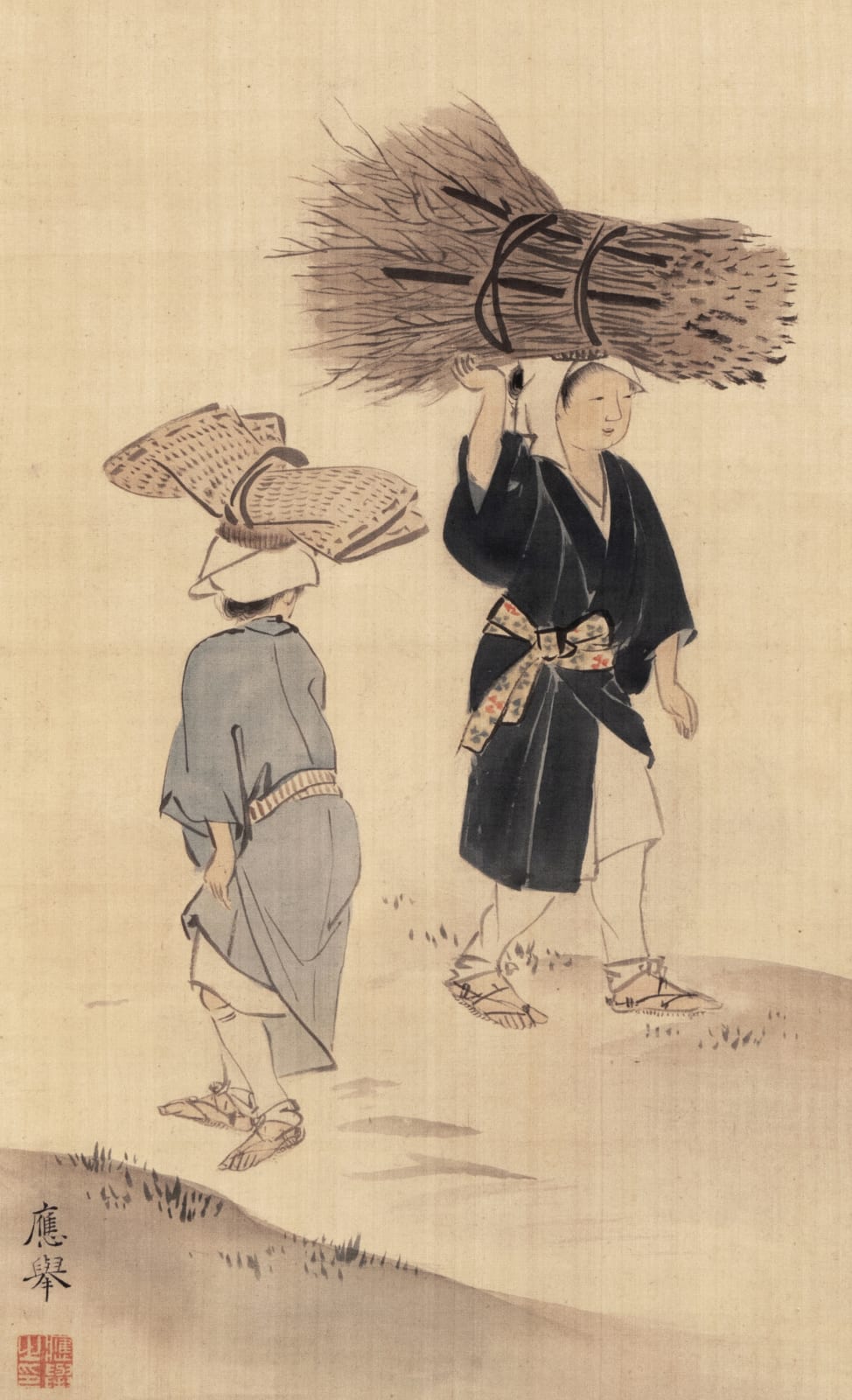




Okyo Maruyama (1733-1795)
Oharame, 1770s
Sumi ink on paper
26-1/2”h x 11-1/2’w ; scroll, 55-1/2”h x 12-3/4”w
Further images
Oharame (women peddlers from the region of Ohara) plied their trade in the Kyoto countryside from the beginning of the Heian period (794 CE) until the end of the Meiji...
Oharame (women peddlers from the region of Ohara) plied their trade in the Kyoto countryside from the beginning of the Heian period (794 CE) until the end of the Meiji period (1912 CE). They walked around towns and villages selling products from the village of Ohara in baskets and bundles on their heads, and they were regarded as a symbol of rural beauty.
These women came from very little, so their clothing was modest and utilitarian. Their only small luxuries were their sashes, made from pieces of colorful fabric likely purchased during a trip to town. Although a small accessory of modest means, these sashes became a way for the women to express their style and taste during long days of laborious and often dangerous work.
In this painting, one carries a bundle of sticks to be sold as kindling. The other finished her day’s work successfully carrying an empty sack.
Maruyama captures their subtle figurative gestures with ease. Observe the women’s wordless communication as they pass each other. One glances towards the other, her expression shielded from the viewer. The other stares ahead, eyes locked forward with a smile that belies the heaviness of her load.
An astute collector isolated a moment within this painting and emphasized it. He or she chose to celebrate the Oharame’s decorative sash by mounting the painting with a playful and distinct silk fabric resonant with the sash’s pattern, balanced tastefully against a backing of muted wheat silk. The connoisseur “framed” the painted sash with a sharp eye and a knowing joy, and in doing so related to the painting.
About the artist
Maruyama Okyo(1733-1795) was the son of a farmer in the Tamba Province of Japan, what is now the part of the Kyoto Prefecture. During his youth, he spent several years in a monastery studying its collection of ancient Chinese and Japanese paintings. Okyo founded the Maruyama School of painting, which was characterized by a close and accurate observation of nature. Okyo’s sketches, drawn directly from nature, possess a naïve freshness of detail and display a definitive curiosity about exploring surfaces and textures. The innovations in his work and painting philosophy mark him as one of the most influential painters of the 18th century.
These women came from very little, so their clothing was modest and utilitarian. Their only small luxuries were their sashes, made from pieces of colorful fabric likely purchased during a trip to town. Although a small accessory of modest means, these sashes became a way for the women to express their style and taste during long days of laborious and often dangerous work.
In this painting, one carries a bundle of sticks to be sold as kindling. The other finished her day’s work successfully carrying an empty sack.
Maruyama captures their subtle figurative gestures with ease. Observe the women’s wordless communication as they pass each other. One glances towards the other, her expression shielded from the viewer. The other stares ahead, eyes locked forward with a smile that belies the heaviness of her load.
An astute collector isolated a moment within this painting and emphasized it. He or she chose to celebrate the Oharame’s decorative sash by mounting the painting with a playful and distinct silk fabric resonant with the sash’s pattern, balanced tastefully against a backing of muted wheat silk. The connoisseur “framed” the painted sash with a sharp eye and a knowing joy, and in doing so related to the painting.
About the artist
Maruyama Okyo(1733-1795) was the son of a farmer in the Tamba Province of Japan, what is now the part of the Kyoto Prefecture. During his youth, he spent several years in a monastery studying its collection of ancient Chinese and Japanese paintings. Okyo founded the Maruyama School of painting, which was characterized by a close and accurate observation of nature. Okyo’s sketches, drawn directly from nature, possess a naïve freshness of detail and display a definitive curiosity about exploring surfaces and textures. The innovations in his work and painting philosophy mark him as one of the most influential painters of the 18th century.
Signup for our Newsletter
You will receive two emails a month from us. One introduces artworks and design works from Kyoto's hidden sources and the other is stories from Misako, sharing insights into Japanese culture.
* denotes required fields
为了回应您的查询,我们将根据我们的隐私政策处理您提供的个人数据。




